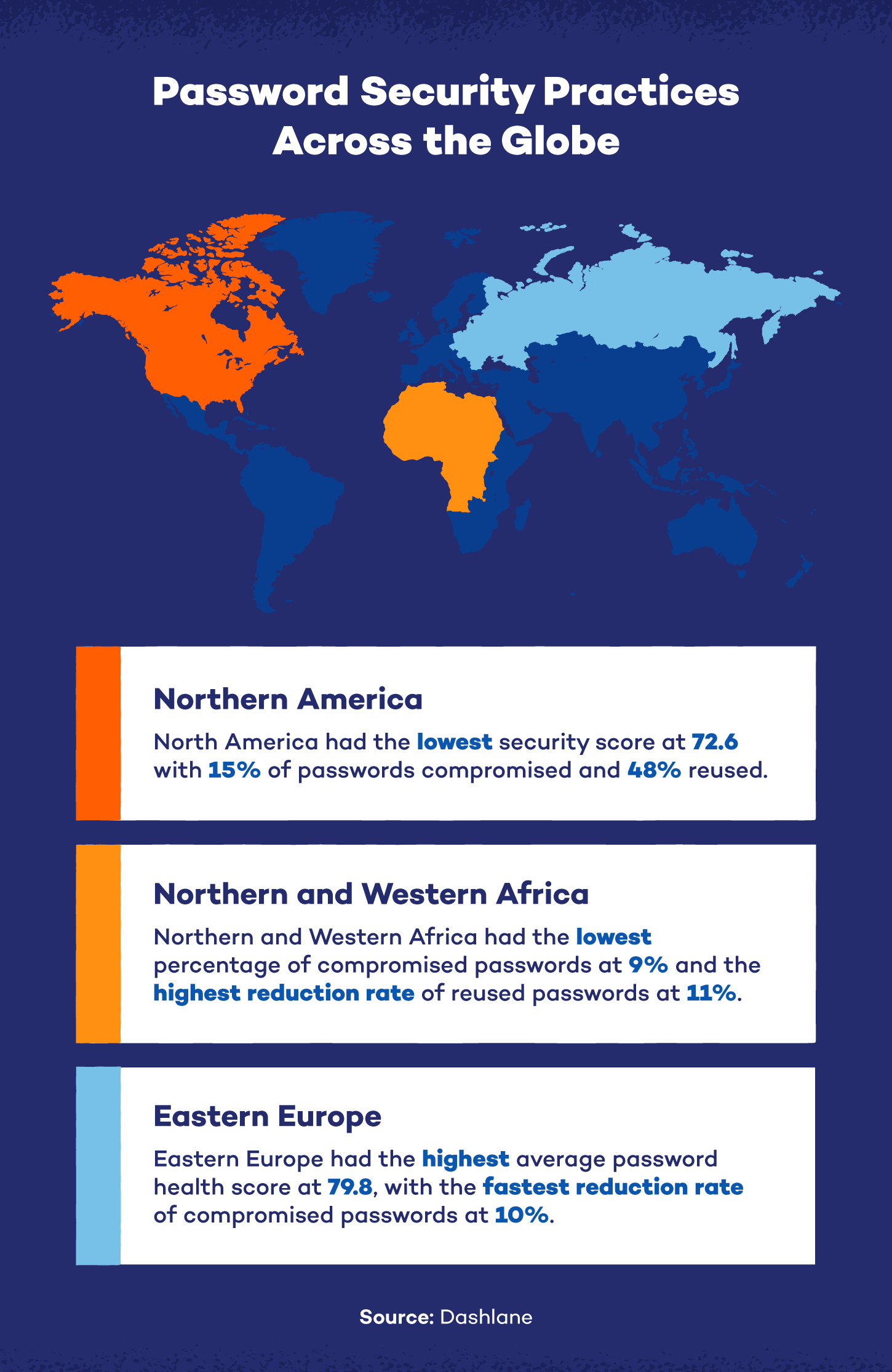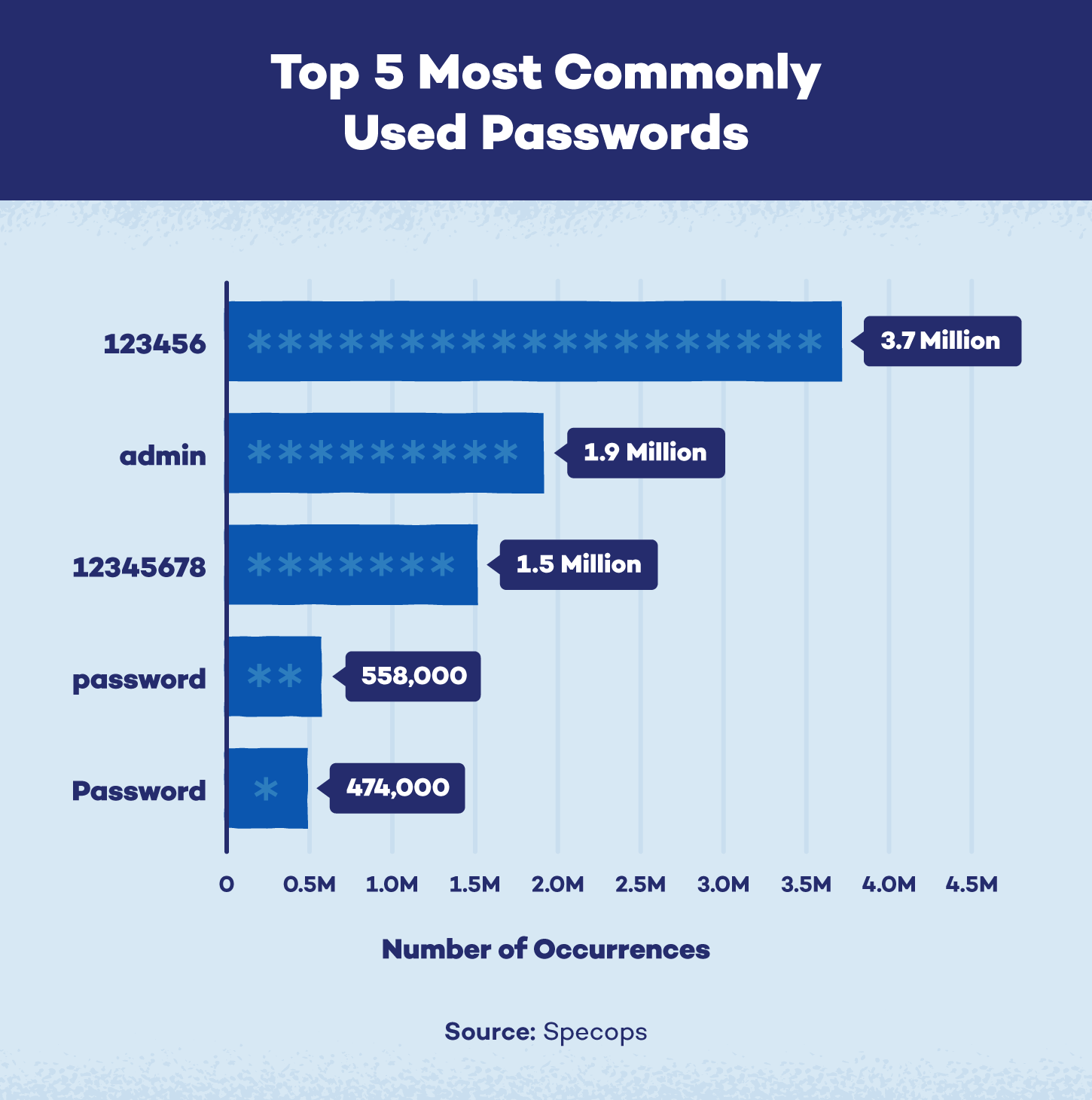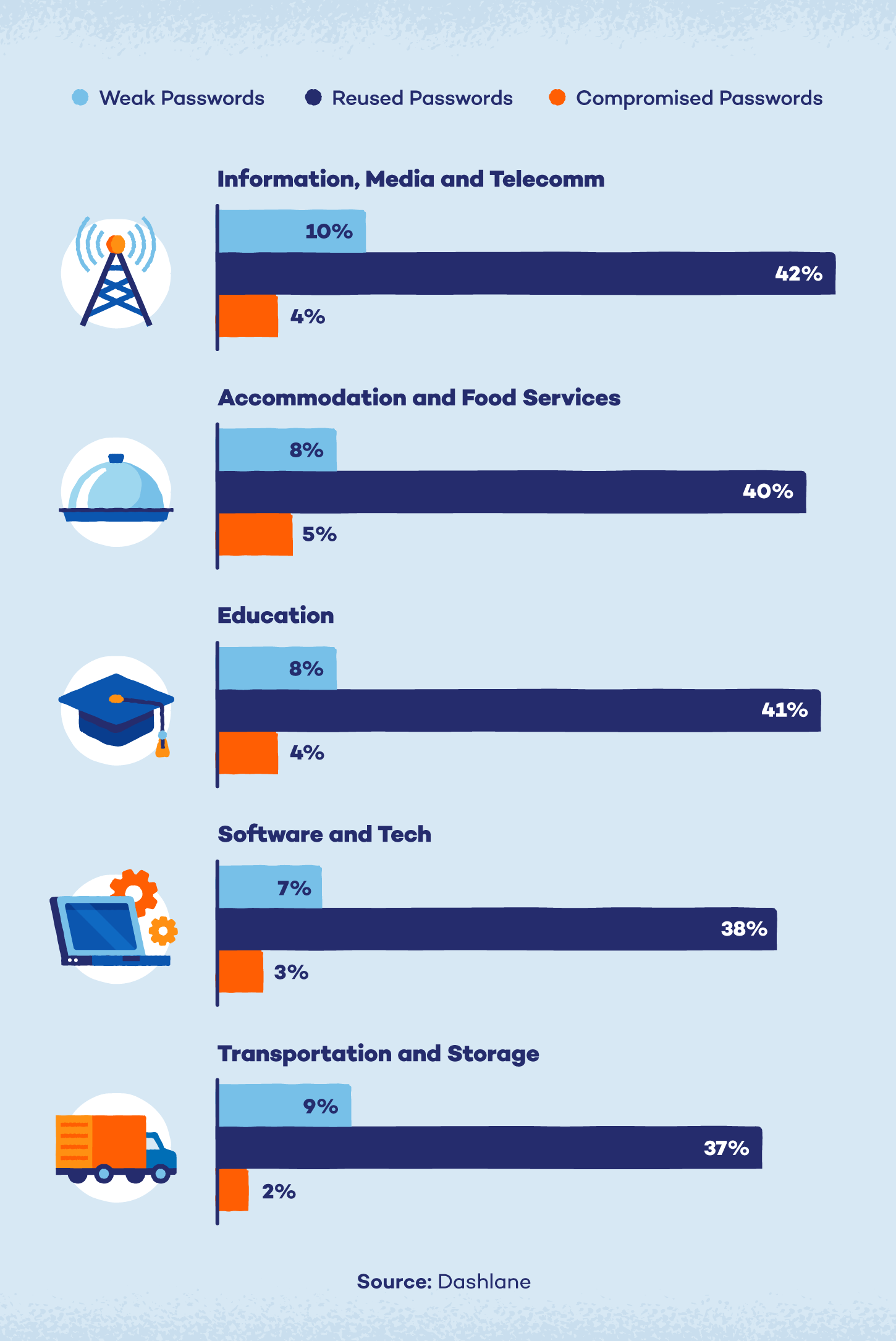Did you know that 1 in 4 people have at least one account compromised due to weak passwords?
We all use passwords to protect sensitive information like bank accounts, work logins and medical records. Yet, many fail to prioritize security and still rely on easy-to-guess passwords — putting their personal data at serious risk.
The password statistics below reveal some alarming consequences of poor security habits. We also explore key password trends, including common mistakes, password reuse habits, data breaches and best practices for stronger protection.
Table of contents:
- Key Password Statistics
- Weak Password Statistics and Habits
- Password Reuse Statistics
- Password Hacking Statistics
- Password Manager Statistics
- Password Security Statistics by Industry
- Password Security Statistics by Company Size
- Password Trends
Key Password Statistics
Understanding key password statistics is crucial for assessing how effectively individuals and organizations are securing their online accounts. These statistics reveal common password practices, security vulnerabilities and trends that can help inform better password management strategies.
- 68% of users had to reset passwords on multiple accounts after a security breach. (Forbes)
- In 2023, “123456” was the most commonly used password globally, appearing over 4.5 million times. (Statista)
- Over 20% of Americans report not doing anything to keep their password safe. (Forbes)
- 1 in 4 people reported at least one account being compromised due to weak passwords. (Fido Advisor)
- In 2024, over 1 billion credentials were stolen by malware. (Specops)

Weak Password Statistics and Habits
While the capabilities of cybercriminals continue to evolve, our password management habits and understanding of proper cybersecurity practices haven’t kept the same pace. This goes for both consumers and businesses, as the statistics below reveal.
- 230 million stolen passwords met standard complexity requirements. (Specops)
- The top five stolen short passwords and their exact matches include “123456” with 3.7 million occurrences, followed by admin at 1.9 million, “12345678” with 1.5 million, password at “558,000” and “Password” with 474,000 matches. (Specops)
- 12345678 and 123456789 were both used more than 1 million times in 2023. (Statista)
- 20% of users report not doing anything to keep their passwords safe. (Forbes)
- 83% of smartphone users say that they take steps to protect their mobile devices through security features such as setting a passcode. (Pew Research Center)
- Among smartphone owners, 16% say they never use a security feature like a passcode, fingerprint or face recognition to unlock their phone. (Pew Research Center)

Password Reuse Statistics
Password reuse is a major security risk, as it allows cybercriminals to easily access multiple accounts once a single password is compromised. Despite the growing awareness of this threat, many users continue to reuse passwords across different platforms.
- 34% of users use strong passwords but repeat variations of them across different accounts. (Keeper.io)
- 23% of people use the same password across three to four different accounts. (Forbes)
- 14% use the same password for five to six accounts, 7% for seven to eight accounts and 4% for nine to 10 accounts. (Forbes)
- 4% of people use the same password for 11 or more accounts, exposing themselves to significant risks due to extensive password reuse. (Forbes)
Password Hacking Statistics
With hackers becoming more sophisticated, understanding the latest statistics on password hacking can help individuals and organizations better protect themselves. Let’s look at the most recent data on password hacking trends and their impact.
- In 2024, the average cost of a data breach increased to $4.88 million, up from $4.45 million in 2023. (IBM)
- Malicious insider attacks had the highest costs, averaging nearly $5 million, followed by business email compromise, phishing, social engineering and stolen or compromised credentials. (IBM)
- 11% of people say their email or social media account has been taken over without permission. (Pew Research Center)
- 7% of users report that someone has tried to open a line of credit or apply for a loan in their name. (Pew Research Center)
- 80% of successful data breaches stem from compromised login credentials. (Keeper.io)
Password Manager Statistics
Password managers are becoming increasingly essential for securing online accounts and sensitive information. As cyberthreats continue to rise, more individuals and businesses are turning to these tools for better password management. In this section, we’ll explore key statistics that highlight the growing adoption and impact of password managers.
- Password manager adoption saw a slight increase in 2024, with 36% of American adults subscribing to these services, equating to 94 million users, up from 34% in 2023. (Security.org)
- Users with password managers were less likely to experience identity or credential theft in the past year, with 17% affected compared to 32% of those without. (Security.org)
- 30% of internet users rely on password managers to keep track of their passwords. (Bitwarden)
- 44% of users said they started using password managers because they frequently forgot their passwords. (Bitwarden)
- Over 75% of people who don’t use a password manager say they would consider adopting one if it provides the right balance of usability, security and affordability. (Security.org)
- Only 7% of respondents globally recognize password managers as the best way to achieve personal cybersecurity. (Keeper.io)
Password Security Statistics by Industry
Cybercriminals pose a significant risk not only to home users but also to large organizations across various industries. However, the impact varies significantly between sectors. Compliance regulations differ greatly, and some industries are more proactive in adopting and maintaining robust security measures than others. Let’s have a look:
- Finance, industrial sector, professional services and technology accounted for 47% of the 604 organizations affected by data breaches. (IBM)
- Entertainment, health care and research were the least affected, with only 2% of the 604 organizations experiencing data breaches. (IBM)

- Construction has the highest percentage of reused passwords (52%) and weak passwords (13%), making it one of the most vulnerable sectors. (Dashlane)
- Health care also struggles with security — 49% of passwords are reused and 5% are compromised. (Dashlane)
- Manufacturing has the highest percentage of reused passwords (43%) but one of the lowest rates of compromised passwords (2%). (Dashlane)
- Energy and utilities maintain relatively better security, with only 10% weak passwords and 3% compromised. (Dashlane)
- Legal has a high percentage of reused passwords (42%) but a lower rate of compromised passwords (4%). (Dashlane)
Password Security Statistics by Company Size
- Midsize businesses (100-999 employees) had the lowest share of compromised passwords at 1.9%, compared to small businesses and enterprises. (Dashlane)
- Small businesses had the highest percentage of compromised passwords at 3.4%. (Dashlane)
- Enterprises had 2.9% of passwords compromised, placing them between small and midsize businesses. (Dashlane)
Password Trends
- Most Americans continue to rely on risky password practices. More than half of adults use unsecured methods, such as memorization, browser storage or written records, to manage their passwords. (Security.org)
- 69% of users believe it’s more important for a password to be secure than easy to remember. (Bitwarden)
- 25% of users globally said they use strong, unique passwords for all their accounts. (Keeper.io)
- 19% of people believe enabling multi- or two-factor authentication is an effective way to protect against online breaches. (Keeper.io)
- The top ways people are keeping their passwords safe are Face ID at 31% and a password manager at 30%. (Forbes)
- According to Forbes, the top password mistakes people made in 2024 include:
- Writing passwords down: 38%
- Relying on memory to remember passwords: 35%
- Storing passwords on their computer: 24%
How to Improve Your Password Security
Improving your password security is essential in protecting your online accounts from cyberthreats. Implementing stronger and more unique passwords, along with additional security measures, can significantly reduce the risk of unauthorized access. Here are some practical tips to enhance your password security:
- Create passphrases using random, unrelated words: Using random words that don’t form a logical phrase makes it much harder for hackers to guess or crack your password. Combining unrelated words also increases password complexity.
- Set up 2FA: Two-factor authentication (2FA) adds an extra layer of security by requiring a second form of verification, such as a code sent to your phone, in addition to your password.
- Use keyboard patterns that are non-linear and unpredictable: Avoid using common keyboard patterns like “qwerty” or “12345.” Opt for random, unpredictable patterns that are harder to guess.
- Incorporate emojis or special characters, if supported: Adding emojis or special characters can further complicate your password, making it more difficult for hackers to crack.
- Use different email addresses for sensitive accounts: For extra security, use unique email addresses for important accounts, such as banking or shopping sites, to reduce the risk of phishing attacks.
- Use a password generator: A password generator can create strong, random passwords that are harder to crack. Consider using a trusted password manager to keep track of them securely.
Strengthen Your Security Today With Panda
Creating strong, unique passwords is one of the most important steps you can take to protect your online accounts from cyberthreats. With passwords being a prime target for hackers, it’s essential to ensure they’re complex and hard to guess. Panda’s Password Generator simplifies this process by creating strong, random passwords for you, helping to enhance your security effortlessly.
For a more streamlined and secure password management experience, consider using a reliable password manager like Panda Dome.
FAQ
How Many Passwords Does the Average Person Have?
The average user has about 168 passwords for personal accounts and an additional 87 passwords for work, totaling approximately 255 passwords.
Which Is the Most Hacked Password?
“123456” is the most hacked password. It’s been used over 3 million times and has been involved in more than 50 million data breaches.





